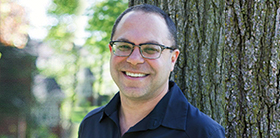What if certain cancer patients could be spared invasive and uncomfortable biopsies? What if they could also be spared unnecessary chemo and radiation treatments?
Looking at patients with oropharyngeal (throat) cancer, Dr. Jeffrey Chankowsky, associate professor of Diagnostic Radiology at McGill, and his multi-hospital team hope to use hidden data from imaging exams to map tumour texture and eventually determine what kind of tumour a patient has and how best to target treatment.
In the prospective study, 60 patients will be recruited and tested to see if their tumour is negative or positive for human papilloma virus (HPV). “We are trying to establish whether patients with HPV-associated oropharyngeal cancer have a different type of tumour,” says Dr. Chankowsky. Recruitment for the study is still ongoing as this is not a common cancer.
HPV-positive patients tend to have a better prognosis, and the thinking is that identifying them early could lead to more targeted, less toxic treatments. Currently the only way to find out is to perform a biopsy. “That’s an invasive procedure and can involve complications,” says Dr. Chankowsky.
A mathematical analysis using McGill-developed software will be performed to map the textures of both the HPV-positive and -negative tumours using data from different types of scans (MRI, CT and PET) that is otherwise invisible to the naked eye.
Eventually, a tumour texture database will be built that physicians will be able to consult to determine the tumour type and the best treatment for that type.
Dr. Chankowsky says the information from these analyses can be used for much more than HPV status. In the future, he says, we could use it to track how patients progress and then apply that knowledge to other patients with the same type of tumour.
“For example, this patient has texture ABC, so the oncologist will know these are patients that tend to recur faster, and they tend to occur at the tumour site and with the lymph nodes, and that may need more radiation therapy. Versus another patient who is in the category of high responders, who don’t recur very much, so we can use a less toxic approach and give them less chemotherapy.”
“It’s basically a more individualized therapy based on the genomic makeup of the actual tumour,” adds Dr. Chankowsky.
September 15, 2017

